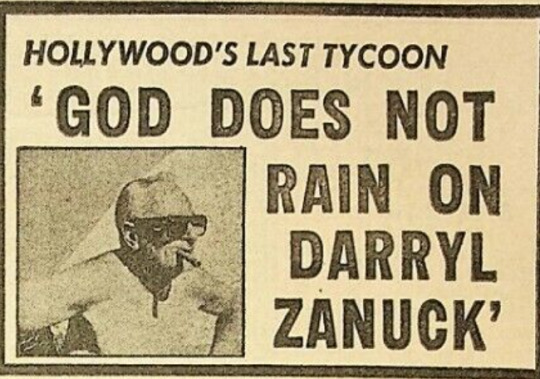#darryl f. zanuck
Text

“There is nothing duller on the screen than being accurate but not dramatic.”
- Darryl F. Zanuck (September 5, 1902 – December 22, 1979)
39 notes
·
View notes
Text
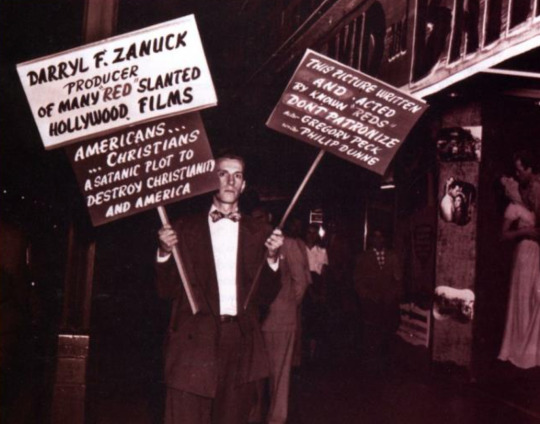
Hollywood Films: A Satanic Plot to Destroy Christianity and America
24 notes
·
View notes
Text

Darryl F. Zanuck dances with Joan Bennett at Sundown after-premiere party, 1941
16 notes
·
View notes
Text

#The Longest Day#film#60s#black and white#Normandy#World War II#World War 2#Darryl F. Zanuck#realism#tw: war#tw: violence#1940s
4 notes
·
View notes
Text

Darryl F. Zanuck, September 5, 1902 – December 22, 1979.
8 notes
·
View notes
Photo
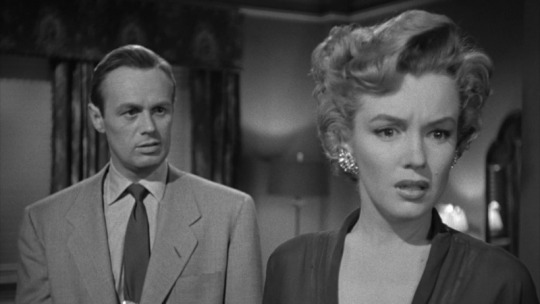
Don’t Bother to Knock (1952)
On social media, there are certain actors from Golden Age Hollywood whose imagery, on occasion, seeps through the Internet’s algorithmic modern biases. Too often, those posts are from individuals who have never seen such actor’s movies. Chief among those actors are James Dean, Marlon Brando, Audrey Hepburn, and Marilyn Monroe. Against the grain, I hold that James Dean’s posthumous legacy has overshadowed three performances I am no fan of and Brando’s airbrushed reputation leaves him overvalued in the popular written histories of American cinema. By contrast, Audrey Hepburn’s standing in modern times feels just about correct (although more people should seek out her films beyond 1953’s Roman Holiday and 1961’s Breakfast at Tiffany’s). For Marilyn Monroe, a recent film like Andrew Dominik’s Blonde (2022) follows decades of works that have exploited her image – oftentimes simplifying her to a tragic sex symbol. Monroe, of the four aforementioned Old Hollywood actors who show up from posts from non-film buffs, is the only one whose talents I consider underrated.
There is no better showcase of her early-career dramatic abilities than in Roy Ward Baker’s film noir Don’t Bother to Knock, released by 20th Century Fox. Up to this point, Monroe had starred in more than a dozen films in supporting roles. In a time when actors and film crewmembers were contracted to a studio, Fox loaned Monroe early in her career to Columbia, Metro-Goldwyn-Mayer (MGM), and most recently to RKO. Fox executive Darryl F. Zanuck was still not entirely sure what to make of her, despite a strong performance in RKO’s Clash by Night (1952). Offering Monroe the lead role in Don’t Bother to Knock, Zanuck gave her the opportunity to prove herself (in addition to ascertaining British director Roy Ward Baker’s skills for his first Hollywood picture). Wary of the risks of pushing an actress to her first lead role as well as working with an unfamiliar director, Zanuck allowed a budget that, by Fox’s standards in the early ‘50s, was a trifle. Yet, because of these limitations, Don’t Bother to Knock is a decent noir and a solid Marilyn Monroe vehicle.
One night in a New York City hotel, airline pilot Jed Towers (Richard Widmark, one of Fox’s brightest stars at this time) approaches his ex-girlfriend Lyn Lesley (Anne Bancroft in her film debut), the hotel club’s singer. Lyn broke up with Jed recently by letter, and explains to her ex that her reasoning is due to his attitude. Jed, flustered, heads back to his room. On the same floor Jed is on but across the air shaft, elevator operator Eddie Forbes (noir mainstay Elisha Cook Jr.) introduces his niece Nell (Marilyn Monroe) to guests Peter (Jim Backus) and Ruth Jones (Lurene Tuttle). Nell will serve as babysitter to the Jones’ daughter, Bunny (Donna Corcoran), while the couple attend a reception downstairs. All is set in motion when Jed first sees Nell across the way.
Also in the cast is Don Beddoe as Mr. Ballew. And Disney fans might recognize Verna Felton – the Elephant Matriarch in Dumbo (1941) and the Fairy Godmother in Cinderella (1950), among others – playing Mr. Ballew’s meddling wife, Emma.
Don’t Bother to Knock’s categorization as a film noir comes from its storyline, rather than its visuals. Bar one scene involving Jed believing someone on the other side of the room to be asleep, the film lacks the shadowy aesthetic one comes to expect from noir. Shot and lit conventionally, Don’t Bother to Knock never quite escapes the fact it is obviously soundstage-bound. The small number of different locations for the film’s various scenes also does not help matters. From a perspective of style, this is a disappointing effort from cinematographer Lucien Ballard, who had ample experience in film noir by this point – see The Lodger (1944) and The House on Telegraph Hill (1951) in this collaboration with Baker.
Yet it is the two central performances that elevate the material. The audience is witnessing Marilyn Monroe before sporting her platinum blonde locks. The natural brunette keeps her natural hair color for this film; not truly transforming into the Marilyn that most casual film audiences know about until Niagara (1953). Unlike the typecast dumb blonde roles that she received later in her career, her role in Don’t Bother to Knock is neurotic, restless, and wide-eyed not in a sexual way. Monroe brings a level of internal strife strewn across her face, a measured gait, and a nervous avoidance of eye contact with Richard Widmark and other actors opposite her. To yours truly, having seen Monroe in so many other roles, it was difficult for me to connect her speaking voice – high-pitched, like a streetwise Snow White living in urban America – to this character’s neuroses. She does not attempt much modification in her delivery or register, whether in this role or others. But given that this is early in her career, this can slide. It is otherwise a solid turn that justifies Zanuck’s supposed gamble on her as a lead actress.
After his debut in Henry Hathaway’s Kiss of Death (1947) for 20th Century Fox, Richard Widmark became one of the studio’s prize actors. His role as the sneering, misogynistic, and psychopathic Tommy Udo brought instant notoriety, as well as spawning fan clubs in American colleges and universities known for their sexism. Early in his Fox career, he would largely play villains, but cinephiles knowledgeable of classic Hollywood know that Widmark was equally capable in more honorable roles. In Don’t Bother to Knock, his Jed sits somewhere squarely in the middle – deeply unlikeable, abrasive, yet with glimmers of compassion and helpfulness. That Tommy Udo sneer finds its way onto Widmark’s face, if only for a few passing moments, due to the pain of his recent separation from Anne Bancroft’s Lyn. Despite Jed’s less-than-virtuous qualities, the viewer – because of the situation that transpires between him and Nell – will find themselves rooting for that elusive happy ending in a film noir. Widmark’s performance in Don’t Bother to Knock is not as remarkable as that in Kiss of Death or No Way Out (1950), but he complements Monroe’s performance wonderfully.
Adapted from the little-read and slender book Mischief by Charlotte Armstrong, Don’t Bother to Knock received its adapted screenplay treatment from Daniel Taradash (1953’s From Here to Eternity, 1955’s Picnic). The pulpy screenplay takes place over a few evening hours, refusing to show its entire hand until a little more than halfway through. Eventually, discussion and a depiction mental illness – as it was understood in the 1950s – becomes prominent in the film. By today’s standards, the script’s understanding of mental illness is deficient. It is used more as a plot device rather than something to inspire dialogue about how the individual in question is coping or how the mental health professional have utterly failed them. Some might argue this might detract from the narrative at-large (and noir is very much a narrative-driven subgenre), but I contend that noir with a social conscience only adds depth to the noir tradition.
Director Roy Ward Baker and co-star Richard Widmark, initially frustrated with Monroe’s habits – requiring acting coach, Natasha Lytess, to be on set constantly; frequently asking to take breaks between takes; and constant tardiness – changed their minds when viewing the film’s rushes (the raw unedited footage played back for the director and editor after the film’s shoot is completed for the day). Monroe brought a rawness appropriate for her role in Don’t Bother to Knock, and her inexperience contributed to her believability in the role. As Don’t Bother to Knock made its theatrical premiere in July 1952, some of the nation’s leading movie critics only added to Darryl F. Zanuck’s unease about framing Marilyn Monroe as a lead actress. Ignoring the plaudits from the audiences, Baker, Widmark, and less-prominent critics, Zanuck instead fixated on the likes of The New York Times’ Bosley Crowther claiming that, “Monroe is being groomed by Twentieth Century-Fox for razzle-dazzle stardom… if they also expect her to act, they’re going to have to give her a lot of lessons under an able and patient coach.”
These reviews (that Zanuck spent too much time thinking about) from Crowther and his fellow contemporaries drip with condescension, misogyny, and language more appropriate for a gossip column. For Monroe – only in her mid-twenties and whose shyness and insecurity followed her through all of her life – one can only imagine how hurtful these words and Zanuck’s perceptions must have been. The crafting of the culturally dominant image of Monroe – as a voluptuous and ditzy blonde plaything with no interiority – was beginning to take shape. In the final year that any American could reasonably not have known the name of Marilyn Monroe, Don’t Bother to Knock represents the end of her status as a Hollywood afterthought.
My rating: 7/10
^ Based on my personal imdb rating. My interpretation of that ratings system can be found in the “Ratings system” page on my blog (as of July 1, 2020, tumblr is not permitting certain posts with links to appear on tag pages, so I cannot provide the URL).
For more of my reviews tagged “My Movie Odyssey”, check out the tag of the same name on my blog.
#Don't Bother to Knock#Roy Ward Baker#Richard Widmark#Marilyn Monroe#Anne Bancroft#Donna Corcoran#Jeanne Cagney#Lurene Tuttle#Elisha Cook Jr.#Jim Backus#Verna Felton#Don Beddoe#Daniel Taradash#Charlotte Armstrong#Lucien Ballard#Darryl F. Zanuck#Lionel Newman#TCM#My Movie Odyssey
8 notes
·
View notes
Text

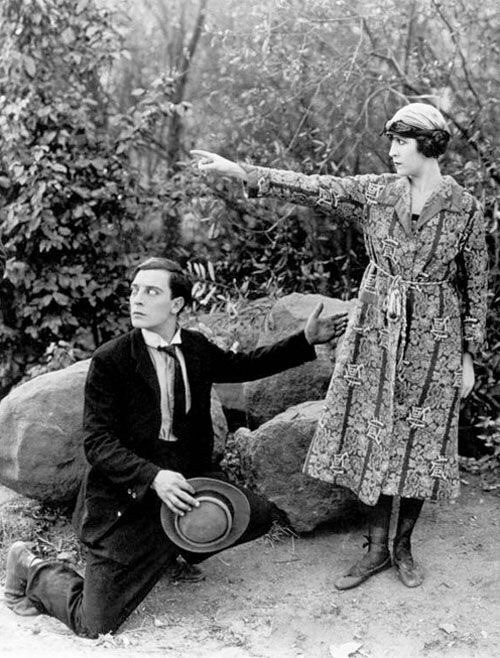
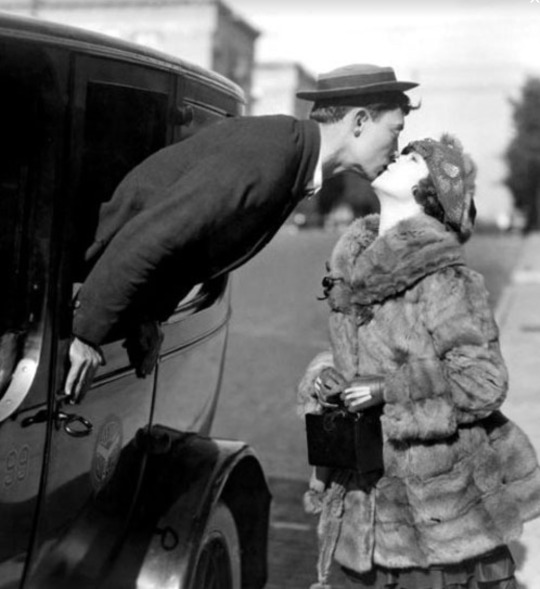
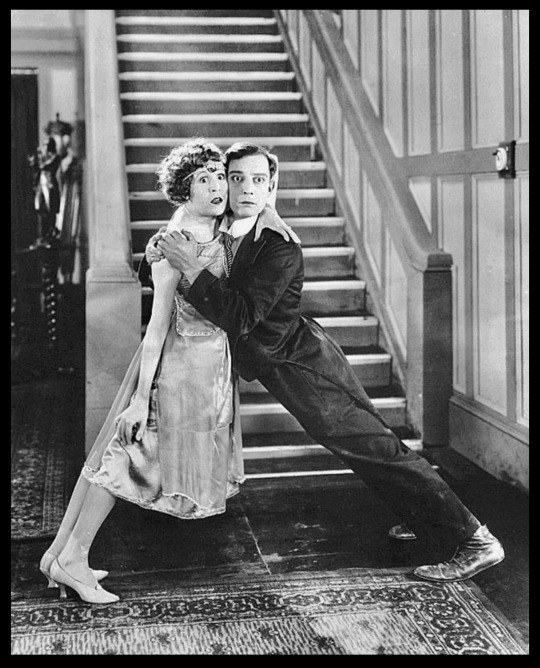

Virginia married Darryl F. Zanuck the producer who co-created Twentieth Century Pictures. Their son Richard Darryl Zanuck was also a film producer who was instrumental in launching the career of director Steven Spielberg
#buster keaton#virginia fox#silent film#silent comedy#1920s#1920s cinema#golden age of hollywood#silent movies#slapstick#comedy#darryl f. zanuck#Richard Darryl Zanuck#20th century pictures
13 notes
·
View notes
Text
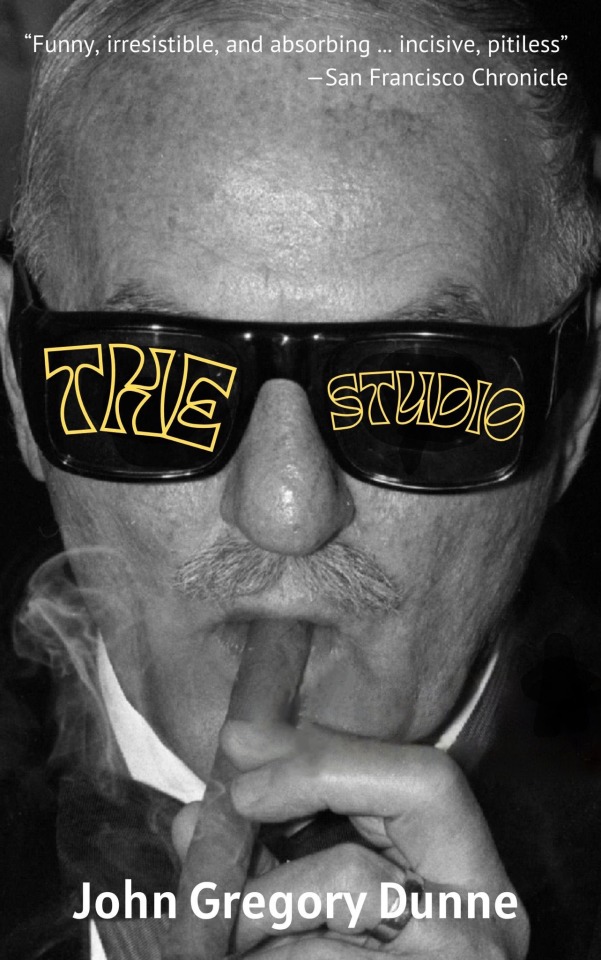
I read The Studio by John Gregory Dunne recently, and was inspired to create my own book cover for it when I saw this photograph of Darryl F. Zanuck chomping on a cigar in 1967.
#the studio book#john gregory dunne#20th century Fox#darryl f. zanuck#richard zanuck#doctor dolittle#planet of the apes#the Boston strangler#cover design#graphic design#my art#my edit#old hollywood#new hollywood
0 notes
Text
Eva contro Eva
Benvenuti o bentornati sul nostro blog. Nello scorso articolo abbiamo deciso di cambiare completamente argomento, passando dal mondo del cinema a quella dei fumetti e continuando ad andare avanti con Kalya, la serie fantasy italiana che ormai conoscete bene qui sul blog, giungendo al volume 8. Dopo essere riusciti a sfuggire a Varnon e il suo Corrotto, il gruppo di Kalya trova rifugio in delle…

View On WordPress
#20th Century Fox#Addison DeWitt#Alfred Newman#All About Eve#Anna Baxter#Barbara Bates#Barbara McLean#Bette Davis#Broadway#Celeste Holm#Darryl F. Zanuck#Eva contro Eva#Eve Harrington#film#Gary Merrill#Gaston Glass#George Sanders#George W. Davis#Gregory Ratoff#Hollywood#Hugh Marlowe#Joseph L. Mankiewicz#Karen Richards#Lyle Wheeler#Margo Channing#Marilyn Monroe#Mary Orr#Milton Krasner#movies#Recensione
0 notes
Text
The Wahoo Boy
Darryl F. Zanuck (1902–1979) was an unlikely Hollywood mogul. Born in a small Nebraska town with an unusual name (both his and the town), Zanuck dropped out of school in the eighth grade, apparently bitten by the acting bug during a brief childhood sojourn in Los Angeles.
Nov. 10, 1934 cover by Constantin Alajalov.
In the first part of a two-part profile, Alva Johnston began to probe the mystery…

View On WordPress
#Alexander I of Yugoslavia#Alva Johnston#Constantin Alajalov#Darryl F. Zanuck#Gardner Rea#George Price#George Shellhase#Gregory d’Alessio#James Thurber#Janet Flanner#Louis Barthou#Morris Markey#Triborough Bridge#Wahoo Nebraska#William Crawford Galbraith
1 note
·
View note
Text
TRAVELLING: CAUTIVOS DEL MAL, LA ‘MALDAD’ PUEDE CREAR BELLEZA
«El propósito de los productoresde cine nunca ha sido, ni deberá ser,el de educar las conciencias,nuestra misión es la de descubrirel tipo de cine que quiere ver la gentey satisfacer al público lo mejor posible»—David O. Selznick
«Siempre he creído que lo buenono era sino lo bello puesto en acción»—Jean Jacques Rousseau
CAUTIVOS DEL MAL (The Bad and the Beautiful, 1952) sigue siendo para mí la…

View On WordPress
#Actriz#Amistad#Arte#Barry Sullivan#Belleza#Bien#Cautivos del mal#Cine#Darryl F. Zanuck#David O. Selznick#Dick Powell#Escritor#Film#Guionista#Harry Cohn#Industria#Irving Thalberg#Kirk Douglas#Lana Turner#Mal#Maldad#Mank#Productor#Productor de cine#The Bad and the Beautiful#Trumbo#Val Lewton#Vincente Minnelli#Walter Pidgeon
0 notes
Text

Darryl F. Zanuck, born on September 5, 1902 #botd

4 notes
·
View notes
Text
TRAVELLING: CAUTIVOS DEL MAL, LA ‘MALDAD’ PUEDE CREAR BELLEZA
«El propósito de los productoresde cine nunca ha sido, ni deberá ser,el de educar las conciencias,nuestra misión es la de descubrirel tipo de cine que quiere ver la gentey satisfacer al público lo mejor posible»—David O. Selznick
«Siempre he creído que lo buenono era sino lo bello puesto en acción»—Jean Jacques Rousseau
CAUTIVOS DEL MAL (The Bad and the Beautiful, 1952) sigue siendo para mí la…
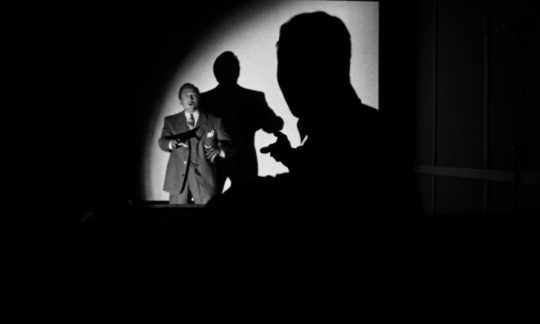
View On WordPress
#Actriz#Amistad#Arte#Barry Sullivan#Belleza#Bien#Cautivos del mal#Cine#Darryl F. Zanuck#David O. Selznick#Dick Powell#Escritor#Film#Guionista#Harry Cohn#Industria#Irving Thalberg#Kirk Douglas#Lana Turner#Mal#Maldad#Mank#Productor#Productor de cine#The Bad and the Beautiful#Trumbo#Val Lewton#Vincente Minnelli#Walter Pidgeon
0 notes
Text
LIFEBOAT - Alfred Hitchcock (1944)
En s’attaquant à la réalisation de Lifeboat, Hitchcock relevait un double défi : montrer qu’un suspense psychologique peut se développer dans un espace aussi réduit qu’un canot de sauvetage, et tourner son film uniquement en studio, en installant une barque à bascule dans un immense bassin, devant un écran de transparences. Les deux paris réussis sont à l’origine d’une des œuvres les plus…

View On WordPress
#alfred hitchcock#darryl f. zanuck#françois truffaut#john hodiak#mary anderson#tallulah bankhead#william bendix
0 notes
Text

Darryl F. Zanuck, September 5, 1902 – December 22, 1979.
9 notes
·
View notes
